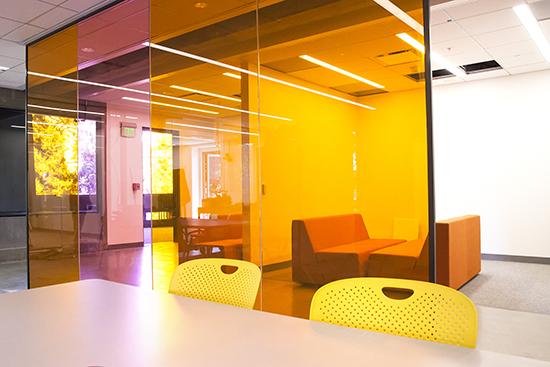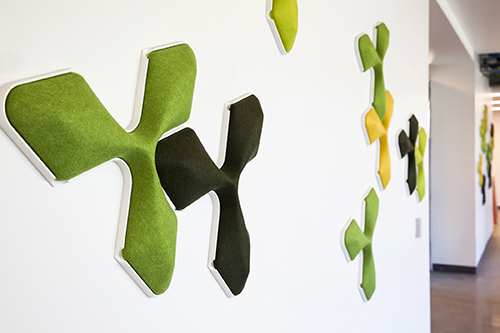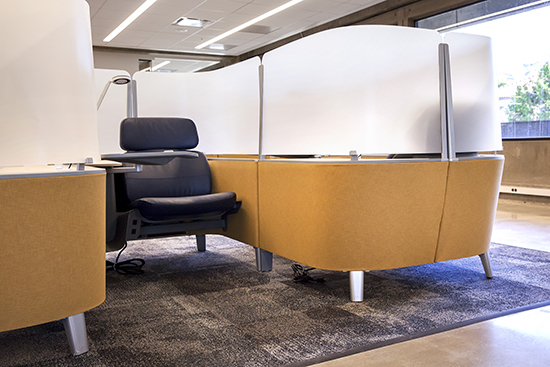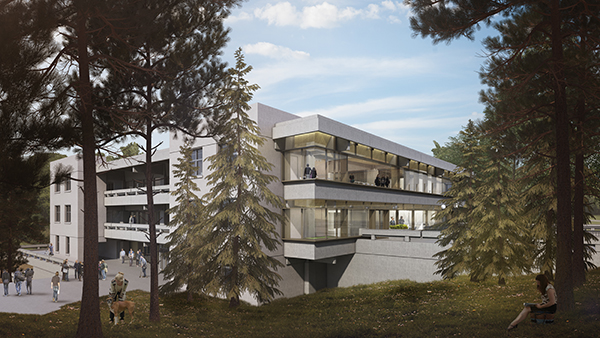Reimagined and revitalized Moffitt Library opens Wednesday
Modernized, 24-hour space offers fresh take on the library's role

November 1, 2016

Colored, writeable glass and bright, movable furniture are key features of the new space. (UC Berkeley photo by Brittany Hosea-Small)
Imagine a 24-hour library where you can write on the walls, rearrange the furniture, eat, drink, talk above a whisper, roll out a prayer rug, sleep in a nap pod, hold a meeting, practice for a job interview and use the latest technology — all with Berkeley’s majestic trees and sweeping landscape as the backdrop.
That dream becomes reality tomorrow (Wednesday, Nov. 2), when Moffitt Library holds a reopening event for its two top floors, transformed after a year of rebuilding into a prime study destination for Berkeley students. Generous donors helped the University Library fund the $15 million modernization project; the campus also performed significant maintenance work on building’s infrastructure.
“This is a very special place,” says University Librarian Jeffrey MacKie-Mason of reimagined floors 4 and 5. “We took one of our 24 libraries and really reconsidered how the space could best serve students. Floors four and five don’t have books, but they are still all about connecting with information, and with technology, to answer questions and solve problems. Two entire floors to support 21st century teaching and and learning.”
At tomorrow’s 2-4 p.m. celebration, “Moffitt Opens Up,” the public is invited to explore the updated new spaces while enjoying music, artwork and demonstrations of virtual reality, drones and 3D printing by students.
Moffitt will now be the only campus library open for 24 hours, five days a week. The new schedule starts Sunday, Nov. 27, with Moffitt open continuously from Sundays at 9 a.m. to Fridays at 10 p.m. On Saturdays, Moffitt will be open from 9 a.m. to 10 p.m.
The Moffitt team
Architect: Gensler
General Contractor: Turner Construction Company
Project Management: UC Berkeley Construction and Design
Unlike traditional libraries, Moffitt no longer has shelves of books, which now are housed at the Main (Gardner) Stacks, a multilevel space with some 2.3 million volumes and an underground entrance accessible from both Moffitt and Doe libraries.
Instead, it was designed as a hub for undergraduates eager to prepare for careers in new ways — by learning to navigate data, access technology and work collaboratively with students from diverse disciplines.
“Our mission as a library,” says MacKie-Mason, “is to help people find, evaluate and use information resources to build a better world. And to teach students to how to become their own information specialists.”
Seats and settings for all

Students Riley Price and Ryan Rodriguez work at the Moffitt Tech Help Desk, which will be moved from the third to the redesigned fourth floor. (University Library photo by Alejandro Serrano)
Workspace for students at Moffitt is now 30 percent larger, says Elizabeth Dupuis, associate university librarian for educational initiatives and user services. “That’s an extra 600 seats — 300 more per floor. Our libraries bustle with Berkeley students from the first days of classes through finals every semester. I suspect Moffitt will become a hot spot throughout the year.”
When students take a seat, it will be after considering a dizzying variety of choices — from modern study carrels for solo studying to flexible group study spaces where the furniture and partitions — made of colorful glass that invites students’ scribbles — are on wheels. Hungry students can pull up to one of the 12-seat, snack-friendly tables on each floor. Or, they can settle into a spot in front of the floors’ numerous windows, their tinted film now removed, which look out into trees or Memorial Glade.

More than 60 lockers at Moffitt are available to students free of charge. (UC Berkeley photo by Brittany Hosea-Small)
On the fourth floor, students will encounter spaces that invite chatter and collaboration, including rooms that can be reserved by campus groups for meetings and classwork, as well as unlimited possibilities in the floor’s flexible work area. They can borrow laptops, iPads, chargers and projectors at the technology lending desk, get walk-up help at the student technology help desk, work on assignments with others — including colleagues overseas — in a studio that offers the latest conferencing tools and, in the Van Houten Presentation Studio, develop, practice and record public presentations.
“Students say that they feel nervous giving presentations. Here they can record themselves with the latest equipment and play it back to spot ways they can improve. This is a great space for groups to practice together and give each other feedback,” says Dupuis.
A BearWALK escort will be stationed on the fourth floor from 10 p.m. to 3 a.m. for students who would like a student community service officer to safely walk them to their near-campus destination. The circulation desk also is on this floor, and there students can get, free of charge, a key to one of about 65 lockers.

Pieces of geometric art on the walls on floor 5 also function as a noise reducer. (UC Berkeley photo by Brittany Hosea-Small)
“We designed the new Moffitt to help reduce student stressors. Lockers can be especially useful for those living off campus; night walks are valuable for those working late; technologies are available here regardless of one’s financial resources,” says Dupuis. “The library offers an environment that frees students to be focused, creative and productive.”
And everywhere, there is ample natural light and bright color, from the furniture to the walls to a rotating selection of artwork by students, alumni and staff members.
“The building is Brutalist architectural style, with lots of gray concrete that we accented with a variety of different types of furniture and colors. Floor 4 has the atmosphere of a co-working space in a trendy warehouse district,” she says.
First renovations since 1970

Individual, all-inclusive work areas on floor 5 offer students a more private study space and include personal lights, outlets, shelves and trays that can prop up a tablet. (UC Berkeley photo by Brittany Hosea-Small)
Floor 5 offers quieter space for individual work and focus, and the colors are more subtle and muted than those on the floor below. There are work lounges with two types of modern study carrels as well as rooms where groups can collaborate, including, as on the fourth floor, writeable glass walls that can be used for brainstorming and collaborating.
The Haas-Herscher Gallery, which will display local art, also is on this floor, as is a wellness room, where students can reserve five lounge chairs for short rests. One of the chairs is a high-tech nap pod.

On floor 5, students can rest in the wellness lounge, where four chairs and a high-tech nap pod (not pictured) can be reserved by students for an hour at a time. (UC Berkeley photo by Brittany Hosea-Small)
“The ASUC developed the rest zone initiative for the campus, and contributed to the selection of the furniture and design of the policies for the wellness room,” says Dupuis. Students will be able to reserve a spot, for an hour at a time, online. Just outside the wellness room is floor space where students could unroll a yoga mat or prayer rug. Classes on stress relief and meditation also will be offered on this floor.
Undergraduate Maddy Abroms, on the 18-member Moffitt Student Advisory Group that was set up in fall 2015 to provide input about renovations to the library, says her favorite upgrade is the wellness room. “It’s a place where students will be able to go and unwind and de-stress,” she says. “I’m proud to attend a school that recognizes the importance of these kinds of spaces, which help remind students of the value of self-care.”

The top floors of Moffitt Library will offer students exciting new study and collaboration spaces. (UC Berkeley image by Gensler)
“We’re going to continue get input from students, experiment with new ideas and evolve this space,” adds Dupuis of the overall plan for the library. “If a particular thing is popular, we’ll try to increase it, and if it’s not, we’ll adjust.”
Floor 4 of Moffitt now has the campus’s newest gender-inclusive bathroom, with 12 stalls and communal, trough-style sinks. And on both floors are family-style tables, where snacking is encouraged — although eating and drinking are allowed elsewhere on floors 4 and 5 — and nearby clean-up caddies encourage students to pick up after themselves.
In 2017, Moffitt’s outside terrace will open and offer more accessible seating, improved lighting and a pop-up café. Moffitt’s renovations are its first since the library opened in 1970. With floors 4 and 5 complete, Moffitt’s first, second and third floors are next on the list to be updated.